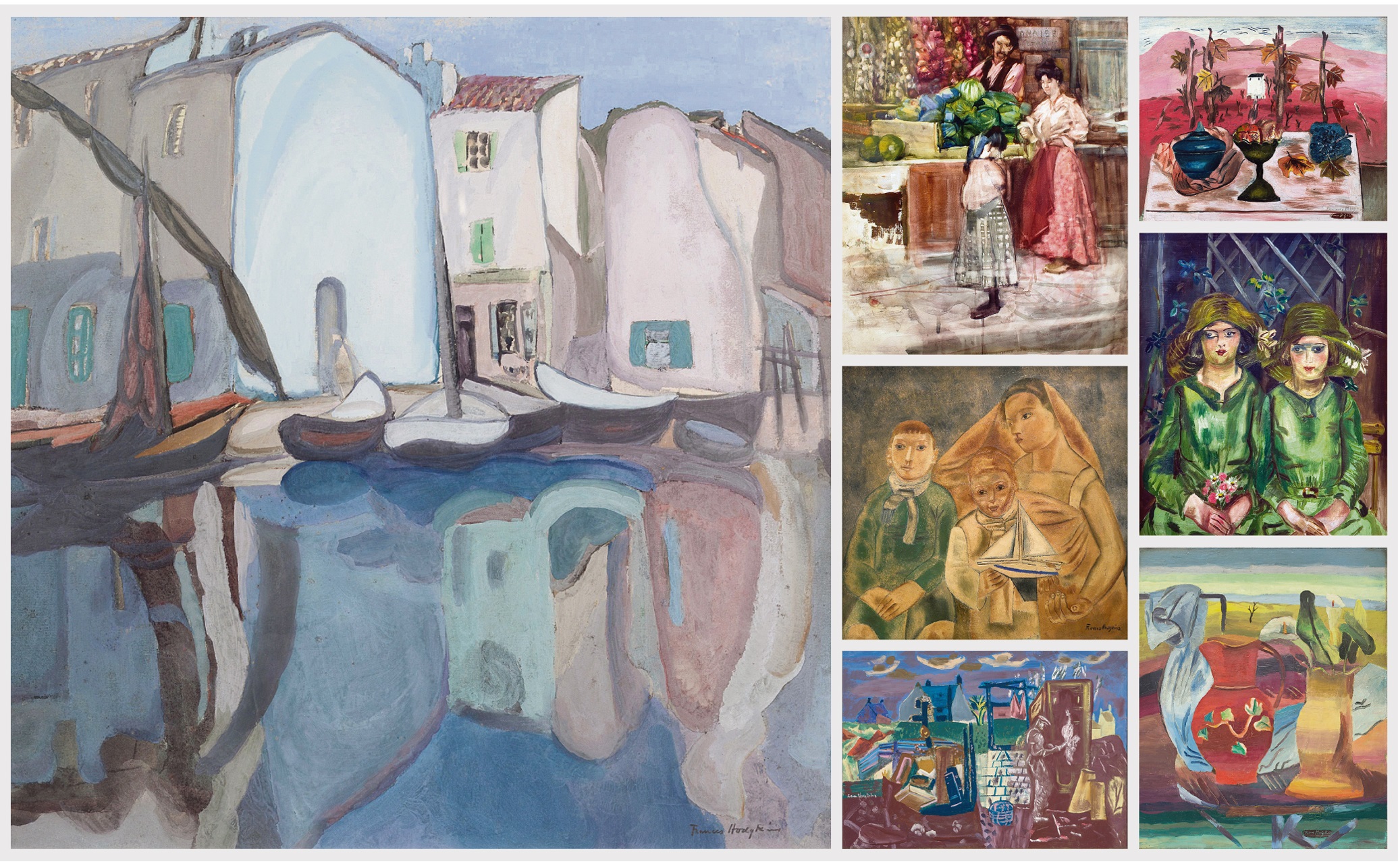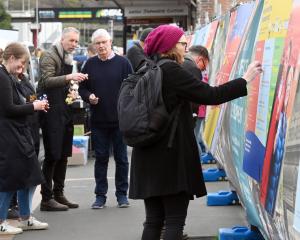
Frances Hodgkins was once asked what goes on inside an artist when they create a picture.
"Ask the hen why it lays an egg," she replied.
Hodgkins is the Dunedin-born artist who went on to become a leading light of British modernism. She's described as a trailblazer and one of this country's most influential painters. Her prowess with colour and light is widely recognised, but she was also, says Auckland Art Gallery senior curator Mary Kisler, a brilliant writer.
"She's very evocative and tongue-in-cheek. And she's very naughty."
Kisler has been immersed in the work and words of Hodgkins since 2014, when the gallery began making plans for a major exhibition, two books and a digital catalogue to mark the 150th anniversary of her birth.
The digital "Catalogue Raisonne" will include transcribed letters, documents and as many of Hodgkins' known works as possible - 860 when the project started, 1350 (and counting) now.
Hodgkins lived and worked throughout Europe and the 160 artworks selected for the commemorative exhibition (which will tour Dunedin, Christchurch and Wellington next year) reflect her lifetime of journeying.
"You think you know things about her and then you discover something else," says Kisler, who recently turned art detective, retracing some of Hodgkins' travels for the new books on her life.
The sources Kisler has been looking through include the artist's letters and old interviews with Hodgkins' friends, which have provided some new insights.
ON LEAVING NEW ZEALAND
Letter to her mother from Caudebec-en-Caux, France, 1901.
"This kind of life quite unfits one for a colonial hereafter - everything is given up to painting, we think & talk of nothing else ... I feel as if I was possessed by a painting devil which is devouring me body and soul & claims all my brains and energy ..."
Mary Kisler: "For the first time she gets the sense she could be a professional artist. In colonial life, in New Zealand, Australia, wherever you went, women were meant to go to afternoon teas; you were meant to leave your cards; there was this kind of regulatory control of how you spent your day. The morning was domesticity and then you got changed and you either had people come to visit you or you went to visit them ... When she got to Europe she realised that she didn't have to be like that - she could paint all day. And I think for her that was like a light going off."
ON BEAUTY
Artist and friend Cedric Morris, speaking about Hodgkins in a documentary made after her death.
"I always felt at ease with her. She was completely unconventional, rather comic, especially to look at, was witty in a strange oblique way and was malicious, again obliquely, and covered up."
Mary Kisler: "At the time that he [Morris] painted a portrait of her, she was wearing her rather eccentric red wig to cover her grey hair and it wasn't because she didn't like having grey hair, it was because she wanted people to judge her art as art. She didn't want people to say `Oh, I won't look at that because it's done by an older woman'. She was also very interested in fashion, although she didn't consider herself attractive ... Her sister was more beautiful, and she knew that good-looking women got more attention. It's that ambivalent thing - being determined to be individual but at the same time, I think that as a young woman at home she was always in second place. Isobel was the taller, more beautiful sister - and her family assumed that Isobel had more talent."
ON ORIGINALITY
Letter to her mother from Hertfordshire, 1903, the year she becomes the first New Zealand artist to hang "on the line" at the Royal Academy's Summer Exhibition.
"It is so easy to paint like your master & to think other people's thoughts, the difficulty is to be yourself, assimilate all that is helpful, but keep your own individuality, as your most precious possession - it is one's only chance."
Mary Kisler: "She looks closely. And she recommends her students look closely. When she is the first woman watercolour teacher in Paris, she tells them to go around all of the contemporary galleries to look at what other people are doing but she says - and this is so important for every artist - that it is an absolute given that you mustn't imitate. Look and learn but then make your own language."
 Mary Kisler
ON CRITICISM
Mary Kisler
ON CRITICISM

Letter to her mother from St Ives, Cornwall, 1918.
"I wish the papers wouldn't make me out a sort of freak artist - I am really a very sober-minded thoughtful sort of person with nothing slapdash or offhand about my work - every stroke I put down comes from real conviction & it is a sincere aspect of truth - if not the whole truth."
Mary Kisler: "There just weren't many women artists getting the kind of recognition she was getting and even though things were difficult in St Ives, it gave her an opportunity to really focus on honing her skills as an oil painter. She talks about `every stroke' and says it is `sincere' - in other words, a painting is a construction. If you look at a lot of contemporary artists, that's exactly what people are still promoting now ... I remember a dealer said once that when you look at an exhibition, don't buy the easiest thing in the show. Keep looking at the most difficult and you may find it gives you the most pleasure in the end. With Hodgkins' more modern works you have to spend time, and some people, more traditional collectors, don't necessarily want to spend time. But that is where Hodgkins is at her most rewarding. I never tire of looking at her works because I'm always finding something else. She is confident, and she is also a great reader; she's reading everything that is being written about art. She gets irritated with somebody who writes a flippant review of an exhibition and doesn't take the effort to try and understand what the artist is trying to do."
ON COLOUR
Letter to D.K. Richmond from Tangier, Morocco, 1903
"The whiteness & pearliness of the town simply defies you - you can't get it pure & brilliant enough & the shadows drive one silly - you race after them, pause one frenzied moment to decide on a blue mauve yellow or green shadow ..."
Mary Kisler: "Morocco was an absolute turning point for her. Partly it was the block-like architecture. She looked at cubes for the first time but also, there's a particular light ... You look at a white wall and it's partly in shadow and if she's following the impressionist tenet you're never going to use black for your shadows but you're going to use dark tones of greens and blues and purples and she could read those colours. She's actually looking at the structure of light, but she's also looking at the effect of light on a flat surface ... When she tries to paint in England in the summer she hates it because everything is leafy-green and it's not so much the colour of the green but she can't see the structure of the branches and the tree trunks. There are bare trees in so many of her works. In the south of France she loves the cork trees and the stripped pink bark, she loves the simple shapes of fruit trees when they're pruned and olive trees when they're cut back."
ON MONEY
Letter to Dorothy Richmond, after she shares the 50 first prize in the Australian women artists' section of the Franco-British Exhibition, 1908.
"For the first time for many months I slept & waked without my pet Bogey Poverty sitting at the foot of my bed."
Mary Kisler: "It's that prize that allows her to go and live in Paris. Sometimes she was very poor but she was also, when she did get money, very generous. A lot of people have written about how supportive Hodgkins' friends and fellow artists were - and they were - but what they write about her is what she gave to them. She was a role model, she was a professional artist - come what may - and she encouraged them all to live by their art, even if it was a sacrifice ... I think too there's something about New Zealanders and maybe it is the colonial thing, a determination to succeed. We sort of punch above our weight often and I think we are a culture that, although we can sometimes be conservative, there is also a very strong strand of people feeling they can be independent, they can follow the path they need to follow and you won't always be respected for it, you won't always be praised for it, but it is what you have to do."
ON TRAVEL
Letter to her friend Barbara Coombs in 1945, the same year she is photographed for Vogue and exhibits alongside Frances Bacon and Henry Moore.
"I am not to be trusted on a Railway station - the longing to board the train & be off is irresistible."
Mary Kisler: "She travelled on average six times a year, apart from during the war. She would choose a place that would stimulate her but, also, hopefully attract students. You travel to be on holiday and to be curious about the world or you travel seeking something and I think she was a seeker. What she was looking for was constant stimulation for her art, but even as a young woman in Dunedin, she and her father and sister would go tramping out on the Otago Peninsula. She was used to walking! There are a number of places that were important - she went back to Martigues five times. She'd work during the day and she liked a bar and she liked a glass of something and a cigarette and that's where she met people and talked, and that galvanised her to get up the next day. She needed company as well. She had to be alone to paint, but she loved to be with people as well - it kept opening up the world to her."
ON MOTHERS (AND MOTHERHOOD)
Letter to her sister, Isobel Field, after the death of their mother in 1926.
"There is an extraordinary bond between a Mother & child - even when you have lived so long apart."
Mary Kisler: "She's staying in Manchester during that period when her mother dies, and she does this whole series of mother and children paintings. They're not specific to her relationship with her mother but in a way, I feel, she's working out her grief. She says later, at the end of her life, `I would have liked to have been married and have children' but I do think she realised, after Isobel got married, that Isobel could only paint once all of her domestic duties were done. Households had to be managed and supervised and Hodgkins had to weigh that up."
ON AGEING
Letter to her friend Ree Gorer, as she reworked paintings rejected by her dealer, 1937.
"At the moment I am nearly buried under a great stack of canvases I am retouching or repainting for my Show - I paint with fearful slowness - Eyes!"
Mary Kisler: "She had real difficulty with her eyesight from the mid '20s on. Those very late, often termed `neo-romantic paintings' - more misty, more abstract paintings - I think partly it's because of her eyesight. It changes your perception. For her, in a way, it was a lucky change because it allowed her to develop another way of painting. But I think why she died was she finally couldn't see enough. Without being able to paint there was no reason to be alive."
ON DYING
Friend David Brynley, from a collection of recordings by Hodgkins' friends and family.
"As I watched her flower-covered coffin before it disappeared I recalled some of her wistful remarks: I would have liked a home and children ... I would have liked to be beautiful ... A good picture, like murder, will out ... I have never forgotten New Zealand, one of the most beautiful countries in the world ... New Zealand is at last beginning to recognise me."
Mary Kisler: "I think there were moments when she was ecstatic. But I think there were moments when she struggled. It often wasn't the poverty, it was when she knew she was trying to do something in her art, because she was constantly evolving her style and when she couldn't, when she didn't yet know how to get there, she really suffered. But then she would find a way - as we all do. We have this problem we think is insurmountable and then we find a way through it. She found a way through it."
Hodgkins: A potted history
1869: Born Frances Mary Hodgkins, third child of Rachel and William, on April 28, in Dunedin.
1890: Exhibits for the first time.
1901: Sails for Europe and begins a lifetime of travel and teaching. Visits England, France, Italy and Switzerland. Travels to Morocco the following year.
1904: The Dunedin Public Art Gallery buys a large watercolour, her first work to enter a public collection.
1908: Moves to Paris, where she becomes the city’s first woman watercolour tutor and sees works by Manet, Monet, Pissarro, Degas, Gauguin and more.
1913: Returns, briefly, to New Zealand and leaves with a reputation as a significant modern artist.
1924: Work becomes influenced by Cubism.
1926: Her mother dies; holds a solo exhibition in Manchester, where the catalogue notes ‘‘she makes each stroke of her brush instinct with life’’.
1929: Joins the avant-garde Seven & Five group (which includes sculptor Len Lye).
1930: Reviewed in London by the Times as ‘‘one of our most original artists’’.
1935: Visits Wales with friend Cedric Morris, who notes her near-blindness.
1936: Wellington’s National Art Gallery and Dominion Museum’s inaugural exhibition includes Hodgkins’ work.
1940: Completes 26 works for the British Pavilion at the Venice Biennale (shown in the United Kingdom when Britain withdraws because of the impending war) and 38 works for a solo show. Reviewed by the Spectator: ‘‘Probably no living painter has such extraordinary powers of arranging colours in original and telling ways ...’’
1947: Dies in hospital in Dorchester, aged 78.
The books
Frances Hodgkins: European Journeys, edited by Catherine Hammon and Mary Kisler (Auckland University Press, $75), and Finding Frances Hodgkins, by Mary Kisler (Massey University Press, $45)
The exhibition
Frances Hodgkins: Eurpoean Journeys, Auckland Art Gallery, May 4-September 1.












